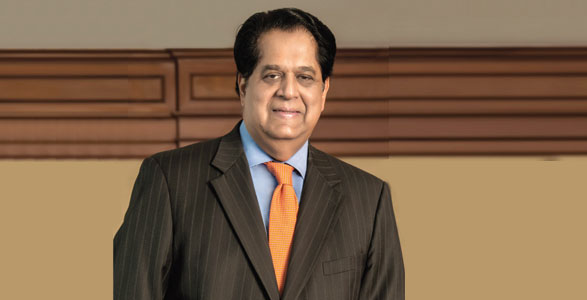
KV Kamath is non-executive Chairman of Infosys and of ICICI Bank. An alumnus of IIM, Ahmedabad, he began his career in 1971 at ICICI, and played a crucial role in transforming ICICI into a technologydriven financial services group and the first universal bank in India
The Indian economy is at a critical juncture in its time in history. It is important to identify our biggest opportunities and work towards leveraging them. In my opinion, they are our demographic dividend, the emergence of a large consuming class, especially growing rural consumption, and the inherent need for infrastructure development in our country.
The first opportunity is India’s demographic that is in a sweet spot to support rapid growth in the country. We will become the youngest country in the world by 2020 with around 20% of the global workforce. That is, India will remain young while the world ages. India’s dependency ratio—the number of dependents per working person—is expected to stay low or decline at least till the next two decades. Falling dependency ratio translates to higher purchasing power, driving our growing consumption story, which brings us to the second opportunity. This is explained best by our rising per capita GDP which has grown from US$465 to US$1,500 within 2000 to 2013. A GDP per capi 46 The Finapolis l February 2015 ta of US$1,000 is the threshold beyond which an economy sees increased affordability and aspirations for better lifestyle. This has tremendous implications for savings growth, consumption demand and the ability to finance investment. As affordability increased, retail consumers became the driver for demand in services. A third opportunity stems from the huge scope for investment in infrastructure. Large deficit in power, roads, transport, urban infrastructure, housing and such calls for huge investment outlay. Since this investment will be to satisfy existing demand and not artificially boost the economy, it is inherently
The focus on manufacturing as envisaged in ‘Make in India’ is poised to create a dual driver alongside the services sector. This has to be accompanied by a concerted focus on usage of technology
sustainable in nature provided it is backed by adequate policy measures.
The post-liberalisation and reforms growth story in India was driven by knowledge-based industries like banking, IT and telecom among others. The services sector, led by these knowledge-intensive industries, witnessed a boom in the 1990s and has sustained through the 2000s. This growth trajectory is an anomaly to the usual development path of a nation where an economy transitions first from agriculture-led to being manufacturing-led, and as it matures further, to an economy led by services. India’s transition has so far been led by knowledgeintensive sectors as contribution of services to India’s GDP rose from 50% in 1990-91 to 67% in 2013-14. Rapid growth was driven by exponential advances in technology and rise in per capita income.
Advances in technology and connectivity have had a major impact in the way we interact, conduct business and manage finances. India has the second largest mobile user base and is close to having the second largest internet user base. Growth in connectivity through larger but lower-cost bandwidth and handheld devices with greater computing power and reducing costs have opened up new avenues for learning, created better access to information and has improved the livelihoods of small entrepreneurs, urban and rural citizens and farmers.
Corporate India, entrepreneurs and common people alike have leveraged opportunities presented by the large population, growing consumption and demand for better facilities, and innovated to solve local problems. An example is, ICICI Bank has about 19 million SB accounts where avg. balance may be just $1 per account and transaction values very small. It is challenges like these that are countered successfully using technologies—biometric authentication, mobile handheld devices—to carry out transactions in semi-urban and rural areas.
Innovation in India has ranged from sachet packing of shampoos to cater to the rural segment to provision of cash-on-delivery by e-commerce to overcome distrust involved with online shopping. Payment providers have introduced e-wallets to facilitate cashless transactions through mobile apps. The ubiquitous nature of mobile apps now provide options to perform transactions from ordering food to booking cooking gas to buying motor vehicles.
 The focus on manufacturing as envisaged in the Make in India programme is poised to create a dual driver alongside the services sector. This has to be accompanied by a concerted focus on the usage of technology which has been the harbinger of innovations in the last few decades. India has strong entrepreneurial energy that is manifested not only in the companies that have successfully grown to a scale, but also in the 45 million small enterprises. There is a need to encourage the vast masses of MSMEs in India by providing an enabling environment, accessible financial support and ensuring simplified mechanisms for starting and doing business. By doing so, we can encourage innovation and entrepreneurship and allow a million ideas to flourish. All these ideas can together combine to help our country take strong strides on the journey to create a self-reliant economy.
The focus on manufacturing as envisaged in the Make in India programme is poised to create a dual driver alongside the services sector. This has to be accompanied by a concerted focus on the usage of technology which has been the harbinger of innovations in the last few decades. India has strong entrepreneurial energy that is manifested not only in the companies that have successfully grown to a scale, but also in the 45 million small enterprises. There is a need to encourage the vast masses of MSMEs in India by providing an enabling environment, accessible financial support and ensuring simplified mechanisms for starting and doing business. By doing so, we can encourage innovation and entrepreneurship and allow a million ideas to flourish. All these ideas can together combine to help our country take strong strides on the journey to create a self-reliant economy.
Written by: KV Kamath